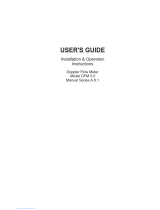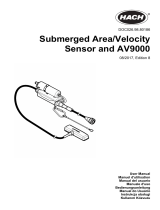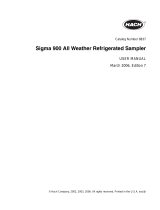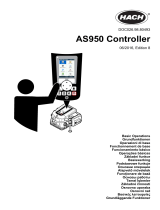La pagina si sta caricando...

IMPORTANT NOTE: This instrument is manufactured and calibrated to meet product specifications.
Please read this manual carefully before installation and operation. Any unauthorized repairs or
modifications may result in a suspension of the warranty.
If this product is not used as specified by the manufacturer, protection may be impaired.
Available in Adobe Acrobat pdf format
Page 3
PDFM 5.0 Portable Doppler Flow Meter
INDEX
Battery...........................................................4
Connections ......................................................4
Keypad System ....................................................5
Calibration Menu ..................................................6
Message .........................................................7
Status............................................................7
Password .........................................................8
Units/Mode .......................................................9
Calibration ......................................................10
Data Logging ....................................................11
Special Functions .................................................12
Sensor Mounting..................................................14
Troubleshooting ..................................................18
Common Questions And Answers ....................................20
Applications Hotline...............................................22
Product Return Procedure...........................................23
Flow Meter Data Sheet .............................................24
Warranty ........................................................25
Specifications ....................................................26
Appendix A - Conversion Table......................................28
Pipe Charts ......................................................29

BATTERY
- A built-in rechargable NiMH battery supplies power for 18 hours continuous operation when fully
charged.
- Display brightness is adjustable to conserve power.
- State of charge is shown for normal use, sleep mode and charging.
- When switched OFF with the AC power module connected the flashing battery indicates charging,
solid battery shows fully charged.
- The PDFM 5.0 will switch off automatically when the battery is fully discharged.
- Full charge requires approximately 6 hours charging.
- Sleep mode extends battery life for long term data logging. Maximum log time is 18 days at 5 minute
sample rate.
CONNECTIONS:
TRANSDUCER:
Use type PSE4 supplied with 12 ft (4 m) cable. Optional 50 ft (15 m) extension cable available.
4-20mA
Active only when powered by AC charger, maximum load 500 ohm.
USB
Cable Part #USB-PD is supplied for connecting the PDFM 5.0 to a PC or laptop.
POWER
An AC powered 15 volt DC power module is supplied for battery charging and continuous use.
Page 4
PDFM 5.0 Portable Doppler Flow Meter
15VDC USB 4-20mA
TRANSDUCER

KEYPAD SYSTEM
The following diagram shows the PDFM 5.0 menu system. Arrows show the four directions to leave a
menu box. Pressing a corresponding keypad arrow will move to the next item in the direction shown.
Move the cursor (underline) under numerals and increase or decrease numerals with the Ç and Èkeys.
To store calibration values permanently, press the ü.
PDFM 5.0 Portable Doppler Flow Meter
Page 5
SLEEP BACK
LIGHT
ON
OFF

CALIBRATION MENU
Page 6
PDFM 5.0 Portable Doppler Flow Meter
--Password----------
Password 0000
--Data Logging-------
>Log Site ID 0
Mode Flow
Set Date Feb 18/2007
Set Time 11:27:40
Interval 10sec
Wrapping NO
Log Logging
USG/min
Tot 20130.8 USG
0.000
--Message-----------
Data log Logging
Battery 50%
Charger Off
Log Used 0%
Sensor Good
--24 hr log----------
>Date Feb. 12/2008
Total 0.000ft/s
Average 0.000ft/s
Maximum 0.000ft/s
Max Time 01:57:00
Minimum -1.046ft/s
Min Time 02:35:00
--Status------------
>Velocity 0.00ft/s
Tot 0.000USG
Signal Cutoff 5%
Signal Strength 0%
Sig Confidence 0
20mA at 40.800USG/s
--Special Functions-
>Language English
Reset Totalizer NO
Negative Totals NO
Reverse Flow NO
Cal Constant 1.000
Restore Defaults NO
New Password 0000
--Simulation--------
>Flow 0.000USG/s
4-20mA 4.00mA
--Units/Mode--------
>Mode Flow
Linear in
Volume USG
Time min
--Calibration-------
>20mA at 2500.0 USG/m
4mA at 0.000 USG/m
Pipe ID 12.00in
Damping 20%
--Configuration-----
>Utility 1.13.04
Doppler 1.08
Logger 1.02S
Relays 0
4-20 Outputs 1
--Menu Selections----
>Units / Mode
Calibration
Data Logging
Special Functions
Simulation
Configuration
Sleep Mode
Logging Stopped
Battery 100%
Charger Off
Sleep Mode Charging

RUN
The main display shows the units selected from the Units/Mode menu,
Flow or Velocity rate being measured, TOTALIZER. The PDFM 5.0 will
start-up with this display and will return to this screen after a timeout if
keys are not pressed in other menus.
MESSAGE
Press Ç from the RUN display to view status of the data logger and
error/warning messages provided by the instrument. The word Message
will appear on the RUN display if error messages are being generated by
the instrument. Press ü to return to the main display.
STATUS
Press È from the RUN display to view instrument status. Velocity will be
displayed in ft/sec or m/sec.
Tot Displays the current totalizer reading.
Signal Cutoff Adjust the setting in percent to suppress flow readings
at zero flow when fluid swirling or pipe vibration may cause the
instrument to continue reading. Example: Signal Cutoff at 5% will force
the display and outputs to zero when signal strength drops below 5%.
Signal Strength Displays percentage of signal being received by the
ultrasonic sensor.
Sig Confidence This indicates consistent or widely varying flow rates
and helps gauge the quality of the velocity signal in the application.
20mA at Displays the flow rate set as 20mA in the Calibration menu.
Press ü to return to the main display.
Page 7
PDFM 5.0 Portable Doppler Flow Meter
USG/min
Tot 20130.8 USG
0.000
--Message-----------
Data log Logging
Log Use 0%
Sensor Good
--Status------------
>Velocity 0.00ft/s
Tot 0.000USG
Signal Cutoff 5%
Signal Strength 0%
Sig Confidence 0
20mA at 40.800USG/s

24 HR LOG
Press Å from the RUN display to view a formatted flow report from
instruments with a built-in data logger. Press È to scroll down one day or
repeatedly to scroll to a specific date. Up to 365 days can be stored.
Newest date will overwrite the oldest. Press ü to return to the main
display.
PASSWORD
The password (a number from 0000 to 9999) prevents unauthorized access
to the Calibration menu.
From the Run display press the Æ key to get to Password. Factory
default password is 0000 and if it has not been changed press the ü to
proceed to the Menu Selections screen.
If a password is required, press Æ to place the cursor under the first digit
and È or Ç to set the number, then Æ to the second digit, etc. Press Æ or
ü to proceed to the Menu Selections screen.
A new password can be stored by going to Special Functions/New
Password.
Page 8
PDFM 5.0 Portable Doppler Flow Meter
--24 hr log----------
>Date Feb. 12/2008
Total 0.000ft/s
Average 0.000ft/s
Maximum 0.000ft/s
Max Time 01:57:00
Minimum -1.046ft/s
Min Time 02:35:00
--Password----------
Password 0000

UNITS/MODE
From >Mode press the Æ and then the Ç or È to select Flow or
Velocity. Flow mode displays the flow rate in engineering units (e.g.
gpm, litres/sec, etc.) Press the ü to store your selection then the È to the
next menu item and Æ to enter.
From >Linear press the Æ key and then the Ç or È to select your units
of measurement. Press the ü to store your selection.
Press the È key to move the > symbol to each subsequent menu item and
the ü to save your selections.
Note: the volume selection "bbl" denotes U.S. oil barrel.
Press Å or ü to return to the Menu Selections screen.
Page 9
PDFM 5.0 Portable Doppler Flow Meter
--Units/Mode--------
>Mode Flow
Linear in
Volume USG
Time min
--Units/Mode--------
Mode Flow
>Linear in
ft
m
mm
--Units/Mode--------
>Volume USG
ft3
bbl
L
m3
IMG
IG
USMG
--Units/Mode--------
Mode Flow
Linear in
Volume USG
>Time sec
day
hr
min

CALIBRATION
Press the È to >Calibration and Æ to enter. Use È or Ç to position
> before each menu item and Æ to enter. When settings are completed
press ü to store and return to the Calibration menu
*20mA at Press Æ then È or Ç to change the numbers and decimal
point. Use this menu to set the corresponding flow rate that will be
represented by 20mA analog output. If maximum flow is unknown, enter
an estimated flow rate and observe actual flow to determine the correct
maximum value. Any velocity or flow rate up to +40 ft/sec (12.2 m/sec)
may be selected.
*4mA at Press È or Ç to set the flow rate corresponding to 4mA analog
output. This setting may be left at zero flow (or velocity or can be raised
to any value less than the 20mA setting, or lowered to any velocity or
corresponding flow rate down to -40 ft/sec (-12.2 m/sec).
Pipe ID Place the cursor under the digits and then È or Ç to change the
numbers and decimal point. Pipe ID should be entered as the exact
inside diameter of the pipe where the sensor is mounted. Refer to the Pipe
Charts Appendix in this manual for inside diameter of common pipe types
and sizes.
Damping - Increase damping to stabilize readings under turbulent flow
conditions. Decrease for fast response to small changes in flow. Damping
is shown in percentage (maximum is 99%). Factory default is 20%.
Press ü from the Units/Mode display to return to Menu Selections.
*Note 4-20mA circuitry is only powered by the AC power module.
To conserve power this output is not active in battery power mode.
Page 10
PDFM 5.0 Portable Doppler Flow Meter
--Calibration-------
>20mA at 2500.0 USG/m
4mA at 0.000 USG/m
Pipe ID 12.00in
Damping 20%

DATA LOGGING
Setup
Select Data Logging from Menu Selections.
Log Site ID Enter a number from 00 to 99. The site ID will
become part of the downloaded file name to help
distinguish downloads from different instruments.
Press ü to store the setting.
Set Date Press Ç or È to scroll and select Month, Day and
Year. Press ü to store the setting.
Set Time Press Ç or È to select the current time in Hours,
Minutes and Seconds. Press ü to store the setting.
Interval Press Ç or È to select the logging interval. Flow rate
reading will be stored at each time interval. Press ü to
store the setting.
Log Select Delete and then Start to apply any changes
that have been made to the logger Interval or Mode.
The current log file will be erased from memory and a
new log file will start.
RETRIEVE LOG FILE
Install Greyline Logger on your PC or laptop. Refer to the Help menu in
the program for detailed instructions.
- Connect the PDFM 5.0 to the PC using the supplied USB cable.
- Install the USB driver program from the install CD.
- Start the Greyline Logger Software.
- Select "xxxx scan for USB instruments xxxx" in the drop down window
at the top of the main window. PDFM 5.0 will be indicated.
- Click the download icon to start transferring data.
- Downloaded data appears in a pop-up window.
Page 11
PDFM 5.0 Portable Doppler Flow Meter
--Data Logging-------
>Log Site ID 00
Set Date Feb 18/2008
Set Time 11:27:40
Interval 10sec
5min
2min
1min
30sec
Log Logging

SPECIAL FUNCTIONS
Language Select English, French or Spanish
Reset Totalizer Press Æ and select Yes to erase and restart the
totalizer at zero.
Negative Totals Select Yes to have reverse flow readings deducted
from the totalizer. Select No to totalize forward flow only and ignore
reverse flow.
Reverse Flow Select Yes to change the display from positive to
negative values.
Cal Constant Set to 1.000 for SE4-A transducer. (Note: Different
transducer models require specific Cal Constants.)
Restore Defaults Select Yes and press ü to erase all user settings
and return the instrument to factory default settings. [review]
New Password Select any number from 0000 to 9999 and press ü.
Default setting of 0000 will allow direct access to the calibration menus.
Setting of any password greater than 0000 will require the password to be
entered to access the calibration menus.
Press ü to return to Menu Selections.
Page 12
PDFM 5.0 Portable Doppler Flow Meter
--Special Functions-
Language English
>Backlight On High
On Med
On Low
Key Hi/Lo
Key High
Key Med
Key Lo
Off
--Special Functions-
>Language English
Reset Totalizer NO
Negative Totals NO
Reverse Flow NO
Cal Constant 1.000
Restore Defaults NO
New Password 0000

SIMULATION
Exercises the 4-20mA output and digital display (does not affect the
totalizer).
Output Press Æ and then È or Ç to change the simulated output. Press
ü to begin simulation. The 4-20mA output and relay states will be
displayed on the screen.
Press the ü to terminate simulation and return to the Menu
Selections screen.
SLEEP MODE
Logging in sleep mode requires a minimum sample time of 30 seconds.
Selecting sleep mode for 10 second sampling rate is indicated by a
flashing display.
BACKLIGHT
Three levels of backlight are selectable to conserve power.
CHARGING
A flashing battery indicates charging.
A solid battery indicates fully charged.
Page 13
PDFM 5.0 Portable Doppler Flow Meter
--Simulation--------
>Flow 0.000USG/s
4-20mA 4.00mA

SENSOR MOUNTING LOCATION
The position of the sensor is one of the most important considerations for accurate Doppler flow
measurement. The same location guidelines apply to Doppler as most other types of flow meters.
Before permanently mounting a Doppler sensor onsite testing is recommended to determine optimum
mounting position. Use the sensor coupling compound (supplied with each Greyline flow meter, or
petroleum gel, acoustic compound or electrocardiograph gel). Take several readings around the axis of
the pipe and then at several points upstream and downstream from the selected position, checking for
consistent readings. Avoid high or low reading areas. Mount the sensor where consistent (average)
readings were obtained or continue testing on another pipe section.
VERTICAL OR HORIZONTAL PIPE - Vertical pipe
runs generally provide evenly distributed flow. On
Horizontal pipes and liquids with high concentrations
of gas or solids, the sensor should be mounted on the
side (3 or 9 o’clock position) to avoid concentrations
of gas at the top of the pipe, or solids at the bottom.
For liquids with minimal gas bubbles (e.g. potable
water) the sensor should be mounted on the top of a
horizontal pipe (12 o’clock position) to obtain the best
signal strength.
VELOCITY INCREASING DEVICES: Generally the sensor must be mounted away from flow
disturbances such as valves, pumps, orifice plates, venturis or pipe inlets and discharges which tend to
increase flow velocity. Velocity increasing devices often cause cavitation, or rapid release of gas
bubbles, and readings both up and downstream may show much higher velocity. As a guideline, mount
the sensor at least 20 diameters upstream or 30 diameters downstream from velocity increasing devices.
Required distance from a velocity increasing device will vary in applications depending on the flow
velocity and the characteristics of the liquid itself.
TURBULENCE INCREASING DEVICES: Elbows,
flanged connections and tees tend to introduce
desirable conditions of an evenly distributed flow
profile with some air or gases entrained in the flow.
Sensor mounting 6 pipe diameters upstream and 10
diameters downstream from these disturbances is
generally optimum.
The sensor is designed to mount longitudinally on a straight section of pipe. Do not attempt to mount it
on bends, elbows or fittings.
Page 14
PDFM 5.0 Portable Doppler Flow Meter
VERTICAL PIPE USUALLY
HAS EVENLY DISTRIBUTED FLOW
12 O'CLOCK POSITION WITH
LOW GAS CONTENT
3 O'CLOCK POSITION WITH HIGH
GAS OR SOLIDS CONTENT
FLOW
SENSOR MOUNTS 6 DIAMETERS
UPSTREAM OR 10 DOWNSTREAM
FROM AN ELBOW

SENSOR MOUNTING
Prepare an area 2" wide by 4" long (50mm x 100mm) for sensor bonding by removing loose paint, scale
and rust. The objective of site preparation is to eliminate any discontinuity between the sensor and the
pipe wall, which would prevent acoustical coupling.
A PC4 Sensor Mounting Kit is supplied with each Greyline flow meter. It includes recommended
coupling compound in a plastic applicator and a stainless steel mounting bracket with adjustable pipe
straps.
Page 15
PDFM 5.0 Portable Doppler Flow Meter
PIPE
Mount the PC4 pipe clamp as illustrated on pipes
0.6" / 15 mm OD or larger. Stainless steel bands are
included for mounting on pipes up to 32" / 81 cm OD.
Additional stainless steel bands (by customer) may be
combined to mount on pipes up to 180" / 4.5 m OD.
END VIEW
SENSOR
ADJUSTABLE
STAINLESS
STEEL STRAP
PIPE
PIPE
SENSOR
PIPE

SENSOR COUPLING
For permanent or temporary bonding, the following are recommended:
a) Dow Corning silicon compound #4 (supplied)
Additional supply: order Greyline Option CC
b) High Temperature compound (supplied with Sensor Option SE3H)
Additional supply: order Greyline Option AP-1W
c) Water-based sonic compound: Order Greyline Option CC30
d) Electrocardiograph gel
e) Petroleum gel (Vaseline)
The above are arranged in their order of preferred application.
d & e are only good for temporary bonding at room temperature.
DO NOT USE: Silicon RTV caulking compound (silicon rubber).
Use the PC4 pipe clamp (supplied) as illustrated above or
use a loop of electrical tape for temporary mounting.
Apply silicon coupling compound #4 to the coloured face
of the sensor. A bead, similar to toothpaste on a
toothbrush, is ideal. Do not overtighten (crush the
sensor).
The sensor must be fixed securely to the pipe with coupling material
between the sensor face and the pipe. Sensor installation with
excessive coupling compound can result in gaps or voids in the
coupling and cause errors or loss of signal. Insufficient coupling
compound will create similar conditions.
Over time temporary coupling compounds (e.g. Petroleum Gel) may
gradually sag away from the sensor resulting in reduced signal
strength and finally complete loss of signal. Warm temperatures, moisture and vibration will accelerate
this process. Dow Corning Silicone Compound #4 as supplied with the PDFM 5.0 (and available from
Greyline Instruments) is recommended for semi-permanent installations.
Page 16
PDFM 5.0 Portable Doppler Flow Meter
COMPOUND
SENSOR
TAPE OR
CLAMP
COMPOUND
PIPE
SENSOR

FIELD TROUBLESHOOTING
Possible Causes: Corrective Action:
METER READING LOWER THAN EXPECTED
Calibration Error •Review UNITS/MODE menu and Pipe ID
Lower flow rate than expected •Investigate pump/valves. Compare velocity
with alternate instrument
Signal not penetrating far enough into the flow
stream
•Relocate sensor closer to elbows or flow
disturbances
Improper mounting of sensor • Reinstall Sensor with careful application of
Coupling Compound
Pipe is not full • Remount Sensor on vertical pipe
METER READING WHEN THERE IS NO FLOW
Vibration on pipe • Adjust Status / Signal Cutoff setting
•Install in another location
Variable Speed Drive interference •Follow Drive manufacturers wiring and
Grounding instructions
•Relocate Flowmeter, Sensor and wiring away
from VSD
Sensor connections incorrect • Refer to Connections diagram
METER READING ERRATIC
Sensor mounted too close to valve, pump or
elbow
• Change sensor placement. Recommended 6-10
diameters from elbows, and 30 diameters from
pumps, controlling valves, orifice plates,
nozzles or open pipe discharge
NO FLOW INDICATION
Not enough suspended particles or gases in the
fluid
•Relocate sensor in more turbulent pipe section.
Mount sensor at 12 o'clock position on
horizontal pipe
Page 18
PDFM 5.0 Portable Doppler Flow Meter

Possible Causes: Corrective Action:
Coupling compound washed out, or sensor loose
on pipe
• Remount sensor
• Use Dow Corning Silicone #4
METER READING TOO HIGH
Calibration error •Review UNITS/MODE menu and Pipe ID
Vibration or noise on the pipeline • Install in another location.
Pipe is not full • Remount Sensor on vertical pipe
Nearby velocity increasing device (pump, valve,
orifice plate)
•Relocate sensor >30 pipe diameters from
velocity increasing device
Variable Speed Drive interference •Follow Drive manufacturers wiring and
Grounding instructions
•Relocate Flowmeter, Sensor and wiring away
from VSD
Page 19
PDFM 5.0 Portable Doppler Flow Meter

COMMON QUESTIONS AND ANSWERS
The pipe vibrates. Will it affect the flow meter?
Common vibration frequencies are far lower than the sonic frequencies used by the Greyline flow meter,
and will not normally affect accuracy or performance. However, applications where very weak Doppler
signal is present (when sensitivity is adjusted to maximum and signal strength is low), accuracy may be
affected by pipe vibration, or the flow meter may show readings under no-flow conditions. Attempt to
relocate the sensor on a pipe section where vibration is reduced, or arrange pipe mounting brackets to
reduce vibration at the sensor mounting location.
The flow meter must be installed in a high noise environment. Will this affect operation?
Greyline flow meters are designed to discriminate between environmental noise and the Doppler signal.
High noise environments may affect the flow meter’s performance where low signal strength and/or low
flow velocities are being measured. Relocate the sensor in a more quiet environment if possible.
Will pipe corrosion affect accuracy of the flow meter?
Yes. Rust, loose paint etc. must be removed from the outside of the pipe to provide a clean mounting
position when installing a Doppler sensor. Severe corrosion/oxidation on the inside of the pipe may
prevent the Doppler signal from penetrating into the flow. If the pipe cannot be cleaned, a spool piece
(PVC recommended) should be installed for sensor mounting.
What effect do pipe liners have on the flow meter?
The air gap between loose insertion liners and the pipe wall prevent the Doppler signal from entering the
flow. Better results can be expected with bonded liners such as cement, epoxy or tar, however an on site
test is recommended to determine if the application is suitable for a Doppler flow meter.
Why is Doppler only recommended for liquids containing suspended solids or gases?
The Doppler sensor transmits sound into the flow stream which must be reflected back to the sensor to
indicate flow velocity. Gas bubbles or suspended solids act as reflectors for the Doppler signal. As a
guideline, Greyline Doppler flow meters are recommended for liquids containing solids or bubbles with
a minimum size of 100 microns and a minimum concentration of 75 ppm. Most applications (except
potable, distilled or deionized water) will meet this minimum requirement.
Can the sensor be submerged in water?
Yes, for short periods of time or by accident, but it is not recommended for continuous operation. The
sensor is constructed to withstand submersion to 10 psi without damage, but external liquid moving in
contact with the sensor can be interpreted as flow and cause false readings.
Page 20
PDFM 5.0 Portable Doppler Flow Meter
/






